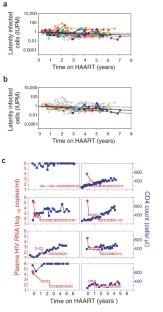Long-term follow-up studies confirm the stability of the latent reservoir for HIV-1 in resting CD4+ T cells (original) (raw)
- Brief Communication
- Published: 18 May 2003
- Joleen Kajdas1,
- Diana Finzi2,
- Thomas C Quinn1,2,
- Karen Chadwick3,
- Joseph B Margolick3,
- Colin Kovacs4,
- Stephen J Gange5 &
- …
- Robert F Siliciano1
Nature Medicine volume 9, pages 727–728 (2003)Cite this article
- 8475 Accesses
- 1349 Citations
- 29 Altmetric
- Metrics details
Abstract
Latent HIV-1 persists in resting memory CD4+ T cells, even in patients receiving highly active antiretroviral therapy (HAART). It has been unclear how stable this latent reservoir is and whether its persistence reflects replenishment by low-level viremia. Here we show that even in treated patients who have had no detectable viremia for as long as 7 years, the reservoir decays so slowly (t1/2 = 44 months) that eradication is unlikely.
This is a preview of subscription content, access via your institution
Access options
Subscribe to this journal
Receive 12 print issues and online access
$209.00 per year
only $17.42 per issue
Buy this article
- Purchase on SpringerLink
- Instant access to full article PDF
Prices may be subject to local taxes which are calculated during checkout
Additional access options:
Figure 1: Extremely slow decay of the latent reservoir in patients on HAART.

Similar content being viewed by others
References
- Gulick, R.M. et al. N. Engl. J. Med. 337, 734–739 (1997).
Article CAS Google Scholar - Hammer, S.M. et al. N. Engl. J. Med. 337, 725–733 (1997).
Article CAS Google Scholar - Perelson, A.S. et al. Nature 387, 188–191 (1997).
Article CAS Google Scholar - Chun, T.-W. et al. Nat. Med. 1, 1284–1290 (1995).
Article CAS Google Scholar - Chun, T.-W. et al. Nature 387, 183–188 (1997).
Article CAS Google Scholar - Finzi, D. et al. Science 278, 1295–1300 (1997).
Article CAS Google Scholar - Wong, J.K. et al. Science 278, 1291–1295 (1997).
Article CAS Google Scholar - Chun, T.W. et al. Proc. Natl. Acad. Sci. USA 94, 13193–13197 (1997).
Article CAS Google Scholar - Finzi, D. et al. Nat. Med. 5, 512–517 (1999).
Article CAS Google Scholar - Blankson, J.N. Annu. Rev. Med. 53, 557–593 (2002).
Article CAS Google Scholar - Zhang, L. et al. N. Engl. J. Med. 340, 1605–1613 (1999).
Article CAS Google Scholar - Ramratnam, B. et al. Nat. Med. 6, 82–85 (2000).
Article CAS Google Scholar - Dornadula, G. et al. JAMA 282, 1627–1632 (1999).
Article CAS Google Scholar - Ruff, C.T. et al. J. Virol. 76, 9481–9492 (2002).
Article CAS Google Scholar - Hermankova, M. et al. JAMA 286, 196–207 (2001).
Article CAS Google Scholar
Acknowledgements
We thank S. Barnett for coordinating patient visits. This work was supported by National Institutes of Health grant AI43222 to R.F.S. and by a grant from the Doris Duke Charitable Foundation.
Author information
Authors and Affiliations
- Department of Medicine, Johns Hopkins University School of Medicine, Baltimore, 21205, Maryland, USA
Janet D Siliciano, Joleen Kajdas, Thomas C Quinn & Robert F Siliciano - National Institute of Allergy and Infectious Diseases, National Institutes of Health, Bethesda, 20892, Maryland, USA
Diana Finzi & Thomas C Quinn - Department of Molecular Microbiology and Immunology, Johns Hopkins University Bloomberg School of Public Health, Baltimore, 21205, Maryland, USA
Karen Chadwick & Joseph B Margolick - Department of Medicine, University of Toronto, Toronto, M5B 1L6, Ontario, Canada
Colin Kovacs - Department of Epidemiology, Johns Hopkins University Bloomberg School of Public Health, Baltimore, 21205, Maryland, USA
Stephen J Gange
Authors
- Janet D Siliciano
You can also search for this author inPubMed Google Scholar - Joleen Kajdas
You can also search for this author inPubMed Google Scholar - Diana Finzi
You can also search for this author inPubMed Google Scholar - Thomas C Quinn
You can also search for this author inPubMed Google Scholar - Karen Chadwick
You can also search for this author inPubMed Google Scholar - Joseph B Margolick
You can also search for this author inPubMed Google Scholar - Colin Kovacs
You can also search for this author inPubMed Google Scholar - Stephen J Gange
You can also search for this author inPubMed Google Scholar - Robert F Siliciano
You can also search for this author inPubMed Google Scholar
Corresponding author
Correspondence toRobert F Siliciano.
Ethics declarations
Competing interests
The authors declare no competing financial interests.
Supplementary information
Rights and permissions
About this article
Cite this article
Siliciano, J., Kajdas, J., Finzi, D. et al. Long-term follow-up studies confirm the stability of the latent reservoir for HIV-1 in resting CD4+ T cells.Nat Med 9, 727–728 (2003). https://doi.org/10.1038/nm880
- Received: 11 February 2003
- Accepted: 22 April 2003
- Published: 18 May 2003
- Issue Date: 01 June 2003
- DOI: https://doi.org/10.1038/nm880